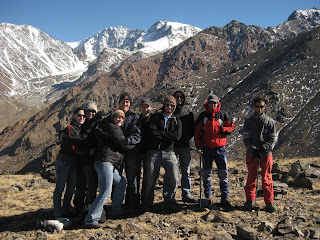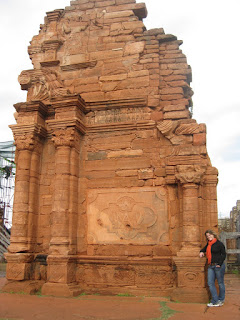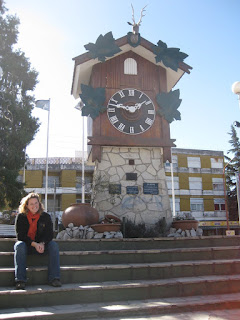Day 1:
The terrain is quite mountainous, so we spent the first part of the day making our way up a winding gravel road.
The top of the mountain isn’t a peak. It’s a large plain covered with cacti.

It also features the straightest road I’ve ever seen.
We spent the night in Cachi, a little town in the mountains.

Day 2:
We made our way south on Route 40, which is Argentina’s equivalent of Route 66. Like most roads in the rural parts of the country, it’s gravel—which is charming at first, but after a couple hours you just want to stop bouncing around. And despite the fact that it’s a two-way road, there are lots of places where it’s just a single lane.

Before long, we were in a desert that featured some incredible rock formations. It was a lot like the Badlands in South Dakota, but even better. Or should I say “even worse”? (Because they’re bad-lands, you see. Never mind.)


That night we stayed in a great town called Cafayate. We sampled a regional dish called locro, which is a delicious stew that includes corn, meat, onions, and plenty of other stuff we couldn’t identify.

Day 3:
A few miles south of Cafayate, we visited the Quilmes ruins. The Quilmes were a tribe that fought off Inca invasions in the 1400s but eventually fell to the Spanish in the 1600s.

Then we drove north (on a paved road!) into the Quebrada de Cafayate. It’s a ravine that features some of the most amazing scenery in the country.


The region is known for its llamas, so Kim was really excited when we finally saw one on the side of the road. Granted, it was tied up for tourists to take pictures of, but it was still fun.

Probably the best rock formation of the day was “The Amphitheater.” It’s a huge wall of rock, probably a couple hundred feet high, with a narrow opening that leads into a wide, circular space.

Days 4 and 5:
Next, we drove north to a town called Humahuaca. On the way there, we found ourselves in the middle of a dust storm. The landscape looked pretty bleak.

That night, the power went out. We’re not sure why, but it was probably related to the dust storm. Even though the entire town was without electricity, we had an ace up our sleeve: we’d simply drive to a town called Tilcara, about 30 miles away. Surely Tilcara would have power! As it turned out, Tilcara was just as dark as Humahuaca. Still, we enjoyed a nice candle-lit dinner. Kim had a bowl of locro, and I tried llama.

The next day we stayed in Humahuaca and just took it easy. The dust storm had passed, and it was a lovely winter afternoon.


Day 6:
We made our way west, through some beautiful mountains. This one is called “The Skirt,” because apparently it looks like a skirt.

We spent the next few hours ascending a huge mountain (over 13,000 feet). When I got out of the car to take this picture, a huge gust of wind caught my door and pulled it wide open. Closing the door required all my strength (which, I’ll admit, isn’t much…but still).

Eventually we got to a really flat, dusty plain. We were super-excited to see some wild llamas on the side of the road. Actually, I think they’re called vicuñas, so they’re not technically llamas.

The terrain was pretty inhospitable. We were shocked to see that people used to live here.

Day 7:
On our final day with the car, we drove through the Quebrada del Toro, which is yet another gorgeous ravine with stunning scenery. There’s a famous railway that runs along this valley, known as the “Train to the Clouds.” But the train tracks and the road follow pretty much the same route, so we took the car to the clouds instead. The only thing missing was the clouds…but I guess we shouldn’t complain about the perfectly clear skies.



Along the way, we stopped at some ruins near a little town called Santa Rosa de Tastil. The area was originally inhabited by a pre-Incan tribe in the 1400s, and the community was home to over 2,000 people. Nobody is quite sure why they left; there’s no archeological evidence of a fight, so it seems unlikely that they were forced out. I guess they just decided to leave.

Our seven-day road trip was probably the most fun we’ve had in Argentina, and that’s saying a lot. It’s a bit sad to be leaving Salta, actually. We’ve been staying with an incredibly kind family at their bed & breakfast (Poncho Huasi in Cerrillos, if anyone is thinking about visiting Salta), and they’ve really made us feel at home. And the bistro down the street (Don Hernando) has provided some of the best meals in recent memory.
So, it’s bittersweet to say goodbye to Argentina, but it’s time to move on. Up next: Bolivia!


























